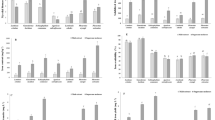Abstract
Mercury, cadmium and cobalt were found to be the most toxic heavy metals, inducing strong growth inhibition of the tested basidiomycetes. The studied species differed significantly in their sensitivity to cadmium. The most sensitive fungus,Inonotus obliquus, did not grow at Cd concentrations higher than 0.1 mmol/L, whereasStereum hirsutum grew at more than 2 mmol Cd/L. Changes in mycelial morphology were observed inS. hirsutum andTrametes versicolor cultivated in the presence of cadmium and mercury. The toxicity of heavy metals was lower in rich, complex media.
Similar content being viewed by others
Abbreviations
- CCBAS:
-
Culture Collection of Basidiomycetes (Institute of Microbiology, Academy of Sciences of the Czech Republic, Prague)
References
Bagy M.M., El-Sharouny H.M., El-Shanawany A.A.: Effect of pH and organic matter on the toxicity of heavy metals to growth of some fungi.Folia Microbiol. 36 367–374 (1991).
Baldrian P., Gabriel J., Nerud F.: Effect of cadmium on the ligninolytic activity ofStereum hirsutum andPhanerochaete chrysosporium.Folia Microbiol. 41, 363–367 (1996).
Gabriel J., Mokrejš M., Bílý J., Rychlovský P.: Accumulation of heavy metals by some wood-rotting fungi.Folia Microbiol. 39, 115–118 (1994).
Gabriel J., Vosáhlo J., Baldrian P.: Biosorption of cadmium to mycelial pellets of wood-rotting fungi.Biotechnol. Tech. 10, 345–348 (1996).
Inouhe M., Sumiyoshi M., Tohoyama H., Masanori J.: Resistance to cadmium ions and formation of a cadmium-binding complex in various wild-type yeasts.Plant Cell Physiol. 37, 341–346 (1996).
Lerch K.: Copper metallothionein, a copper-binding protein fromNeurospora crassa.Nature 284, 368–370 (1980).
Lilly W.W., Wallweber G.J., Lukefahr T.A.: Cadmium absorption and its effects on growth and mycelial morphology of the basidiomycete fungus,Schizophyllum commune.Microbios 72, 227–237 (1992).
Münger K., Lerch K.: Copper metallothionein fromAgaricus bisporus: chemical and spectroscopic properties.Biochemistry. 24, 6751–6756 (1985).
Rózicki H.: Effect of heavy metals (Pb, Zn, Cu and Cd) on germination of conidia ofCylindrocarpon destructans (Zinssm.) Scholten.Zbl. Mikrobiol. 147, 261–269 (1992).
Sanglimsuwan S., Yoshida N., Morinaga T., Murooka Y.: Resistance to and uptake of heavy metals in mushrooms.J. Ferment. Bioeng. 75, 112–114 (1993).
Schmitz S., Weidenborner M., Kunz B.: Heavy metals as selective inhibitors of mould growth.Internat. J. Food Microbiol. 18, 233–236 (1993).
Tien M., Kirk T. K. Lignin peroxidase ofPhanerochaete chrysosporium.Methods Enzymol. 161B, 238–248 (1988).
Author information
Authors and Affiliations
Rights and permissions
About this article
Cite this article
Baldrian, P., Gabriel, J. Effect of heavy metals on the growth of selected wood-rotting basidiomycetes. Folia Microbiol 42, 521–523 (1997). https://doi.org/10.1007/BF02826566
Received:
Issue Date:
DOI: https://doi.org/10.1007/BF02826566




